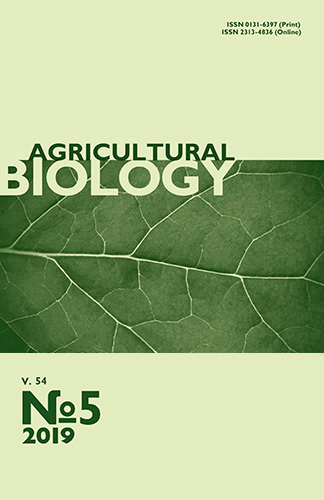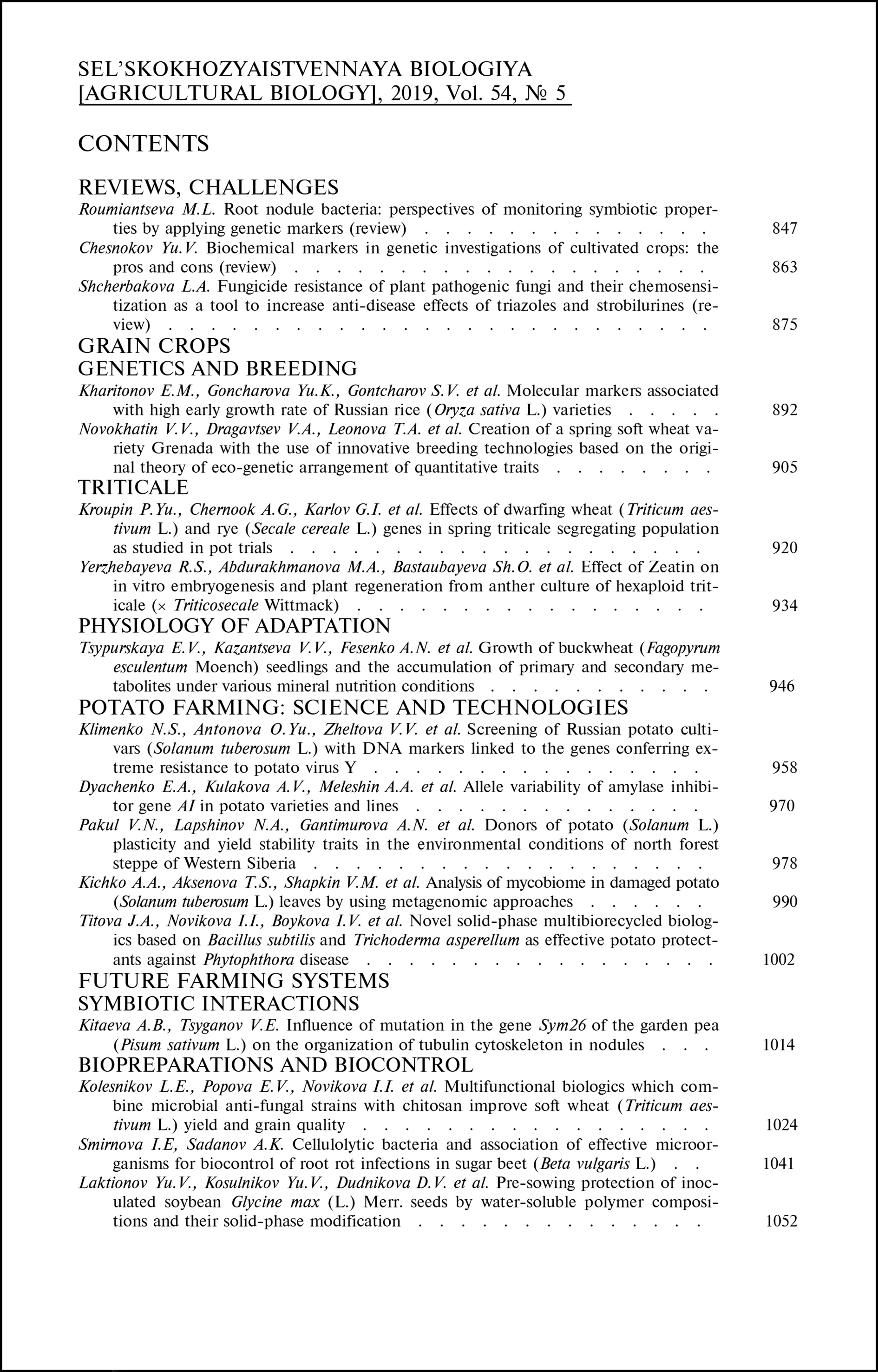doi: 10.15389/agrobiology.2019.5.970eng
UDC: 635.21:577.152.321:577.21
Acknowledgements:
Supported financially by Ministry of Science and Higher Education of the Russian Federation (State Research Sub-Program «Potato breeding and seed production») and by Russian Foundation for Basic Research (grant No. 17-29-08017)
ALLELE VARIABILITY OF AMYLASE INHIBITOR GENE AI IN POTATO VARIETIES AND LINES
E.A. Dyachenko1, A.V. Kulakova1, A.A. Meleshin2, E.Z. Kochieva1
1Research Center of Biotechnology RAS, 33/2, Leninskii prospect, Moscow, 119071 Russia, e-mail dyachenko-el@yandex.ru, kulakova_97@mail.ru, ekochieva@yandex.ru (✉ corresponding author),
2Lorkh All-Russian Research Institute of Potato Farming, 23, ul. Lorkha, pos. Korenevo-1, Lyubertsy Region, Moscow Province, 140051 Russia, e-mail a-mela@mail.ru
ORCID:
Dyachenko E.A. orcid.org/0000-0002-0570-9751
Meleshin A.A. orcid.org/0000-0002-6018-3676
Kulakova A.V. orcid.org/0000-0002-3124-525X
Kochieva E.Z. orcid.org/0000-0002-6091-0765
Received July 13, 2019
The economic efficiency of potato varieties includes not only yield characteristics, but also taste preservation during storage. Storing potato tubers at low temperatures leads to the degradation of starch and the accumulation of reducing sugars; the latter during heat treatment contribute to the deterioration of taste and participate in acrylamide synthesis. Starch degradation to simpler compounds is achieved in two pathways: hydrolytic and phosphorolytic. In the hydrolytic pathway, hydrolases, including α- and β-amylase, are responsible for cleavage of starch, and exhibit different activities depending on the tissue, organ type, cell localization, and plant species. Amylase activity is regulated at the post-translational level by an amylase inhibitor (AI), which binds amylase and blocks the active site of the enzyme, or changes its conformation, thereby reducing the catalytic activity. Although AI role in plant is very important, present data on the AI genes and encoded proteins in representatives of the genus Solanum are extremely limited. In this study, AI sequences were obtained and analyzed in 36 potato varieties and lines of domestic and foreign selection. Two types of AI coding sequence were identified, 621 and 630 bp, depending on presence of 9-bp insert GGTGCAWTT at the 3´-end of the cDNA. The analyzed gene was characterized by an extremely high polymorphism level: exonic sequences contained 134 SNPs (singe nucleotide polymorphisms) (21.3 %), which resulted in 69 amino acid substitutions (33.0 %) in the encoded proteins. Detected GAI/F202 insertion in the C-terminal region of some AI proteins resulted from the 9-bp 3´-gene insertion. Among the 69 amino acid substitutions identified, only 11 are radical and may lead to a change in the protein conformation. All of the analyzed potato accessions were heterozygous and possessed several allelic variants of the gene. In total, 70 allelic variants of the gene and 69 associated protein variants are identified. The largest number of single nucleotide polymorphisms is among the allelic variants of the gene in the varieties Lux (18 substitutions), Irbitskii (17 substitutions) and Gala (16 substitutions). The largest number of amino acid substitutions is in the AI proteins in the Gala (9 substitutions) and Gornyak (8 substitutions) varieties.
Keywords: Solanum tuberosum, potato varieties, amylase inhibitor, AI gene, allelic variants.
REFERENCES
- Devaux A., Kromann P., Ortiz O. Potatoes for sustainable global food security. Potato Research, 2014, 57(3-4): 185-199 CrossRef
- Chandrasekara A., Kumar T.J. Roots and tuber crops as functional foods: a review on phytochemical constituents and their potential health benefits. International Journal of Food Science, 2016, 2016: Article ID 3631647 CrossRef
- Camire M.E., Kubow S., Donnelly D.J. Potatoes and human health. Critical Reviews in Food Science and Nutrition, 2009, 49(10): 823-840 CrossRef
- Simakov E.A. Uspekhi sovremennoi nauki, 2017, 2(10): 44-50 (in Russ.).
- Robertson T.R., Alzaabi A.Z., Robertson M.D., Fielding B.A. Starchy carbohydrates in a healthy diet: the role of the humble potato. Nutrients, 2018, 10(11): 1764 CrossRef
- Streb S., Delatte T., Umhang M., Eicke S., Schorderet M., Reinhardt D., Zeeman S.C. Starch granule biosynthesis in Arabidopsis is abolished by removal of all debranching enzymes but restored by the subsequent removal of an endoamylase. The Plant Cell,2008, 20(12): 3448-3466 CrossRef
- Mukerjea R., Sheets R.L., Gray A.N., Robyt J.F. In vitro synthesis of ten starches by potato starch-synthase and starch-branching-enzyme giving different ratios of amylopectin and amylose. Organic Chemistry Current Research, 2015, 4(3): 142 CrossRef
- Pfister B., Zeeman S.C. Formation of starch in plant cells. Cellular and Molecular Life Sciences, 2016, 73: 2781-2807 CrossRef
- Tang H., Mitsunaga T., Kawamura Y. Molecular arrangement in blocklets and starch granule architecture. Carbohydate Polymers, 2006, 63(4): 555-560 CrossRef
- Sonnewald U., Kossmann J. Starches-from current models to genetic engineering. Plant Biotechnology Journal, 2013, 11: 223-32 CrossRef
- Lloyd J.R., Kossmann J. Transitory and storage starch metabolism: two sides of the same coin? Current Opinion in Biotechnolgy,2015, 32: 143-148 CrossRef
- Orzechowski S. Starch metabolism in leaves. Acta Biochimica Polonica, 2008, 55(3): 435-445.
- Malinova I., Qasim H.M., Brust H., Fettke J. Parameters of starch granule genesis in chloroplasts of Arabidopsis thaliana. Frontiers in Plant Science, 2018, 9: 761 CrossRef
- Sorta kartofelya rossiiskoi selektsii. Katalog /Pod redaktsiei E.A. Simakova [Russian potato varieties. Catalog. E.A. Simakov (ed.)]. Moscow, 2018 (in Russ.).
- Sowokinos J.R. Biochemical and molecular control of cold-induced sweetening in potatoes. American Journal of Potato Research, 2001, 78: 221-236 CrossRef
- Shepherd L.V.T., Bradshaw J.E., Dale M.F.B., McNicol J.W., Pont S.D.A., Mottram D.S., Davies H.V. Variation in acrylamide producing potential in potato: segregation of the trait in a breeding population. Food Chemistry, 2010, 123: 568-573 CrossRef
- Chen X., Song B., Liu J., Yang J., He T., Lin Y., Zhang H., Xie C. Modulation of gene expression in cold-induced sweetening resistant potato species Solanum berthaultii exposed to low temperature. Molecular Genetics and Genomics, 2012, 287: 411-421 CrossRef
- Neilson J., Lagüe M., Thomson S., Aurousseau F., Murphy A.M., Bizimungu B., Deveaux V., Bègue Y., Jacobs J.M.E., Tai H.H. Gene expression profiles predictive of cold-induced sweetening in potato. Functional & Integrative Genomics,2017, 17(4): 459-476 CrossRef
- Tareke E., Rydberg P., Karlsson P., Eriksson S., Törnqvist M. Analysis of acrylamide, a carcinogen formed in heated foodstuffs. Journal of Agricultural and Food Chemistry, 2002, 50(17): 4998-5006 CrossRef
- Kumar D., Singh B., Kumar P. An overview of the factors affecting sugar content of potatoes. Annals of Applied Biology, 2004, 145: 247-256 CrossRef
- Halford N., Curtis T., Muttucumaru N., Postles J., Elmore J., Mottram D. The acrylamide problem: a plant and agronomic science issue. Journal of Experimental Botany, 2012, 63(8): 2841-2851 CrossRef
- Zommick D., Knowles L., Pavek M., Knowles N. In-season heat stress compromises postharvest quality and low-temperature sweetening resistance in potato (Solanum tuberosum L.). Planta, 2014, 239: 1243-1263 CrossRef
- Preiss J. Regulation of the biosynthesis and degradation of starch. Annual Review of Plant Biology, 1982, 33(1): 431-454 CrossRef
- Solomos T., Mattoo A.K. Starch-sugar metabolism in potato (Solanum tuberosum L.) tubers in response to temperature variations. In: Genetic improvement of Solanaceous crops. M.K. Razdan, A.K. Mattoo (eds.). Science Publishers, Plymouth, 2005.
- Wu A.C., Ral J-P., Morell M.K., Gilbert R.G. New perspectives on the role of a-and b-amylases in transient starch synthesis. PLoS ONE, 2014,9(6): e100498 CrossRef
- Hou J., Zhang H., Liu J., Reid S.D., Liu T., Xu S., Tian Z., Sonnewald U., Song B., Xie C. Amylases StAmy23, StBAM1 and StBAM9 regulate cold-induced sweetening of potato tubers in distinct ways. Journal of Experimental Botany, 2017, 68(9): 2317-2331 CrossRef
- Kitajima A., Asatsuma S., Okada H., Hamada Y., Kaneko K., Nanjo Y., Kawagoe Y., Toyooka K., Matsuoka K., Takeuchi M., Nakano A., Mitsui T. The rice alpha-amylase glycoprotein is targeted from the Golgi apparatus through the secretory pathway to the plastids. The Plant Cell, 2009, 21(9): 2844-2858 CrossRef
- Van Harsselaar J.K., Lorenz J., Senning M., Sonnewald U., Sonnewald S. Genome-wide analysis of starch metabolism genes in potato (Solanum tuberosum L.). BMC Genomics, 2017, 18(1): 37 CrossRef
- Zhang H., Hou J., Liu J., Xie C., Song B. Amylase analysis in potato starch degradation during cold storage and sprouting. Potato Research, 2014, 57(1): 47-58 CrossRef
- Barbosa A.E., Albuquerque E.V., Silva M.C.M., Souza D.S., Silva M.C., Oliveira-Neto O.B., Valencia A., Rocha T.L., Grossi-de-Sa M.F. Alpha-Amylase inhibitor-1 gene from Phaseolus vulgaris expressed in Coffea arabica plants inhibits alpha-amylases from the coffee berry borer pes. BMC Biotechnology, 2010, 10: 44-51 CrossRef
- Mckenzie M.J., Chen R.K., Harris J.C., Ashworth M.J., Brummell D.A. Post-translational regulation of acid invertase activity by vacuolar invertase inhibitor affects resistance to cold-induced sweetening of potato tubers. Plant Cell and Environment, 2013, 36: 176-185 CrossRef
- Zhang H., Liu J., Hou J., Yao Y., Lin Y., Ou Y., Song B., Xie C. The potato amylase inhibitor gene SbAI regulates cold-induced sweetening in potato tubers by modulating amylase activity. Plant Biotechnology Journal, 2014, 12(7): 984-993 CrossRef
- Zhang H., Liu X., Liu J., Ou Y., Lin Y., Li M., Song B., Xie C. A novel RING finger gene, SbRFP1, increases resistance to cold-induced sweetening of potato tubers. FEBS Letters, 2013, 587: 749-755 CrossRef
- D'yachenko E.A., Slugina M.A. Vavilovskii zhurnal genetiki i selektsii,2018, 22(1): 108-114 CrossRef (in Russ.).
- Kumar S., Stecher G., Tamura K. MEGA7: Molecular Evolutionary Genetics Analysis version 7.0 for bigger datasets. Molecular Biology and Evolution, 2016, 33(7): 1870-1874 CrossRef
- Choi Y., Sims G.E., Murphy S., Miller J.R., Chan A.P. Predicting the functional effect of amino acid substitutions and indels. PLoS ONE, 2012, 7(10): e46688 CrossRef
- Draffehn A., Meller S., Li L., Gebhardt C. Natural diversity of potato (Solanum tuberosum) invertases. BMC Plant Biology, 2010, 10: 271 CrossRef
- Slugina M.A., Shmel'kova E.O., Meleshin A.A., Kochieva E.Z. Allele diversity for acid vacuolar invertase gene Pain-1 fragment in potato (Solanum tuberosum L.) varieties and lines. Agricultural Biology [Sel'skokhozyaistvennaya biologiya], 2018, 53(1): 132-139 CrossRef
- Carpenter M.A., Joyce N.I., Genet R.A., Cooper R.D., Murray S.R., Noble A.D., Butler R.C., Timmerman-Vaughan G.M. Starch phosphorylation in potato tubers is influenced by allelic variation in the genes encoding glucan water dikinase, starch branching enzymes I and II, and starch synthase III. Frontiers in Plant Science, 2015, 6: 143 CrossRef












